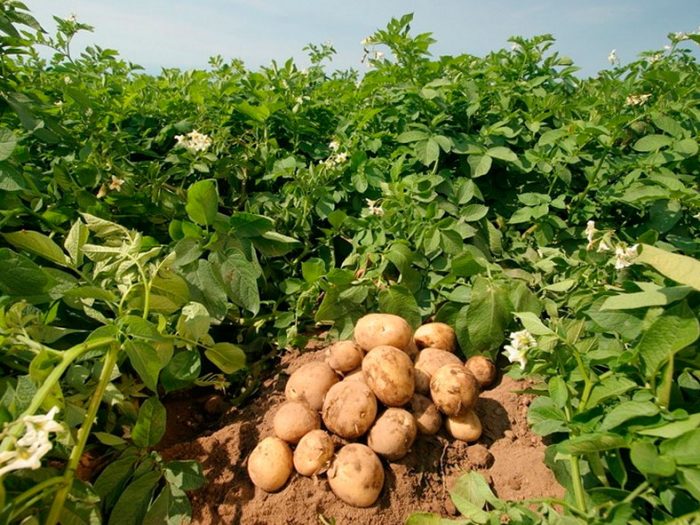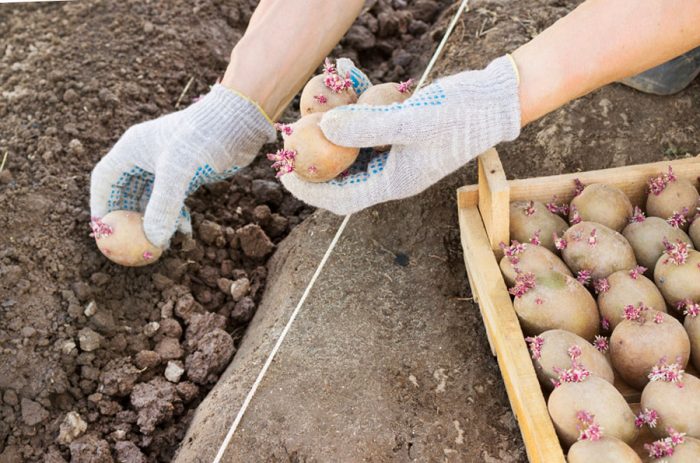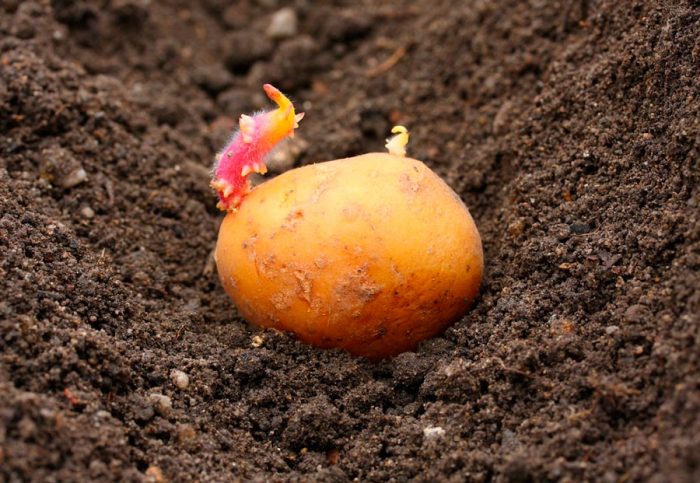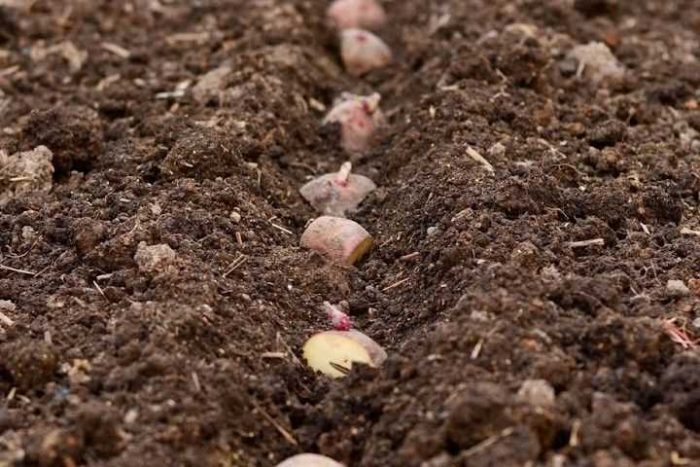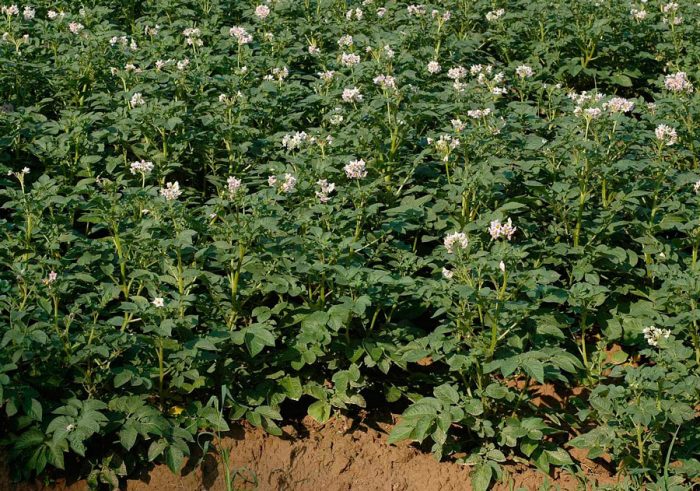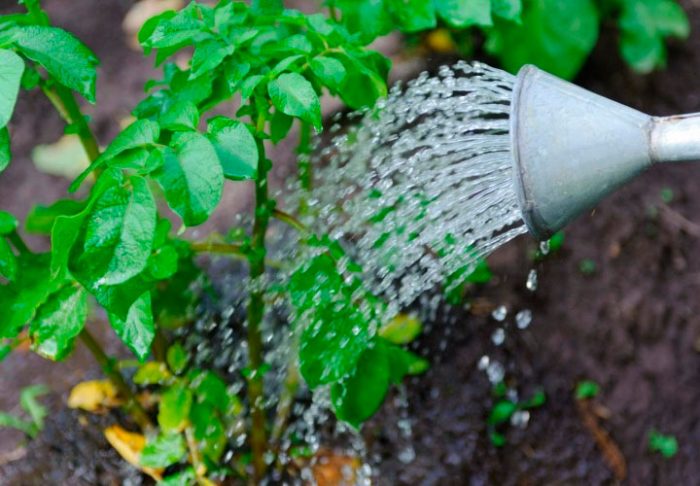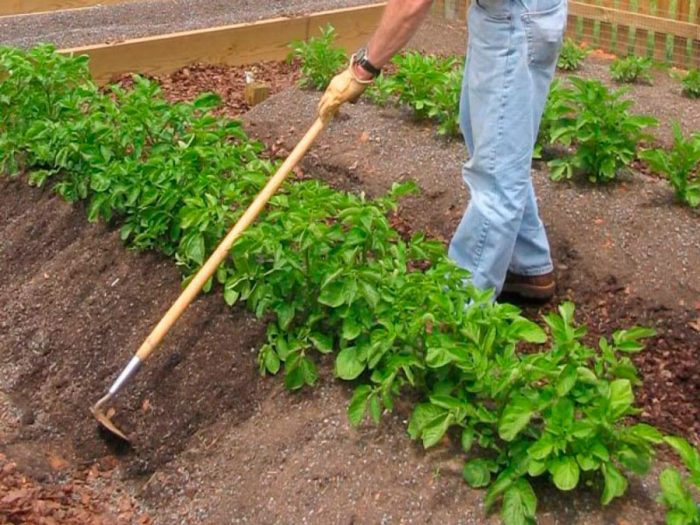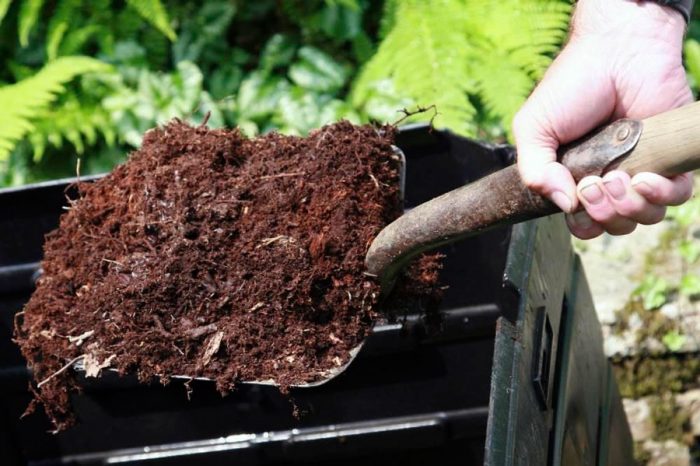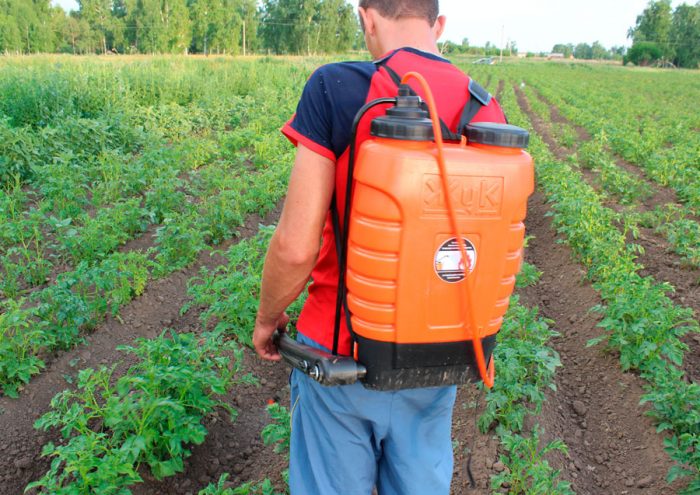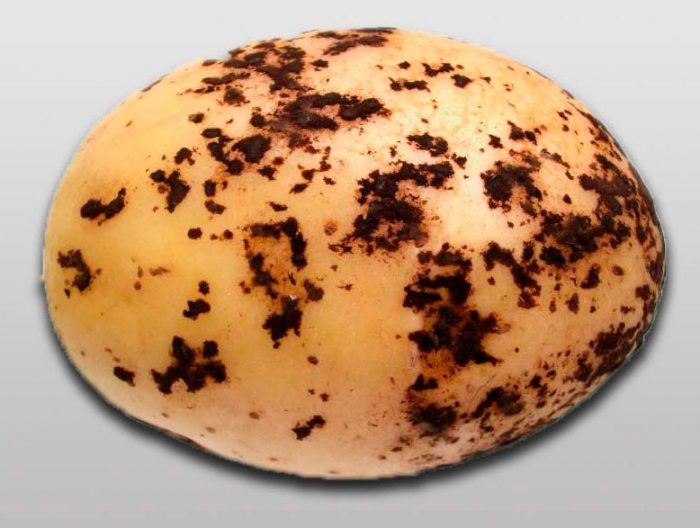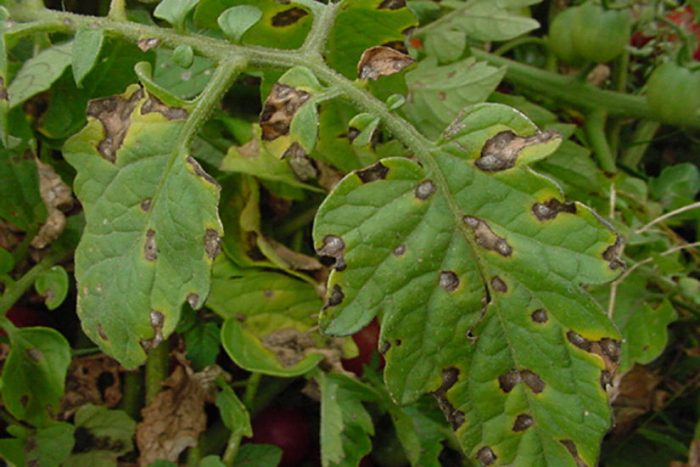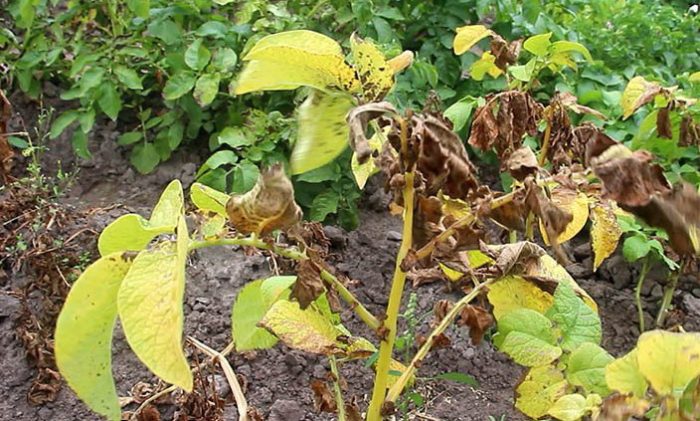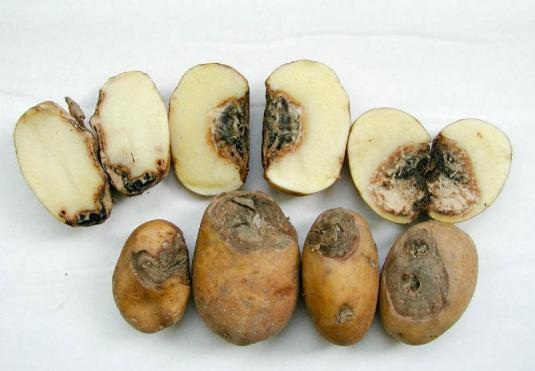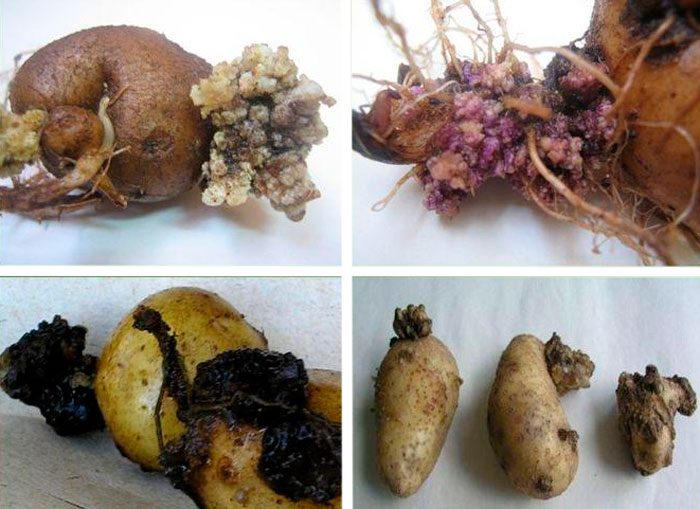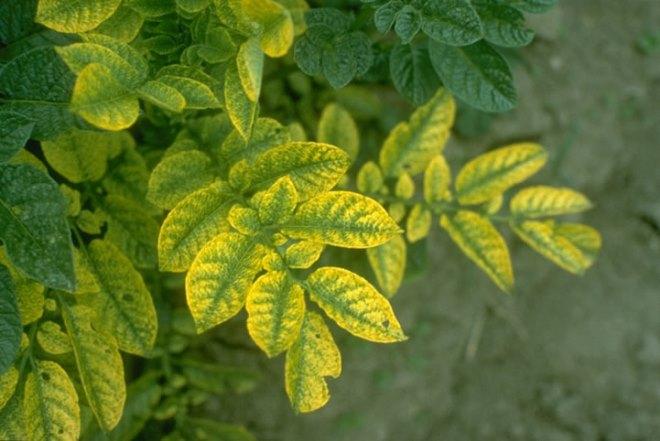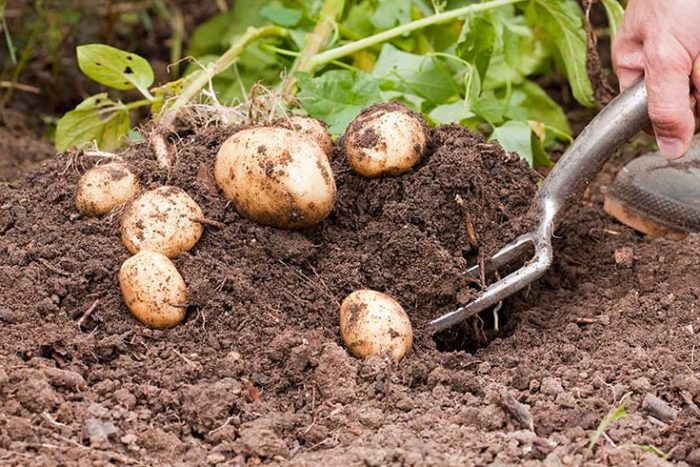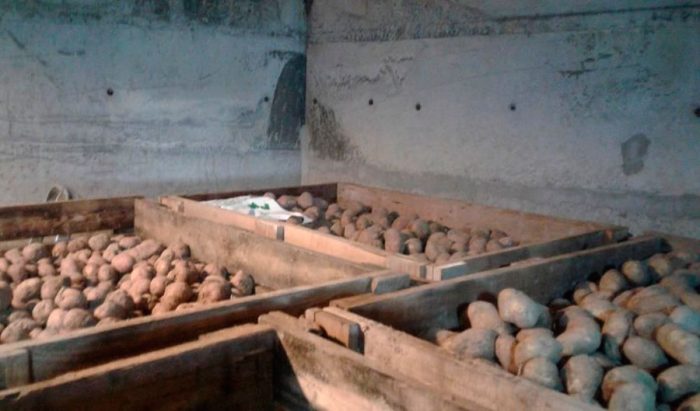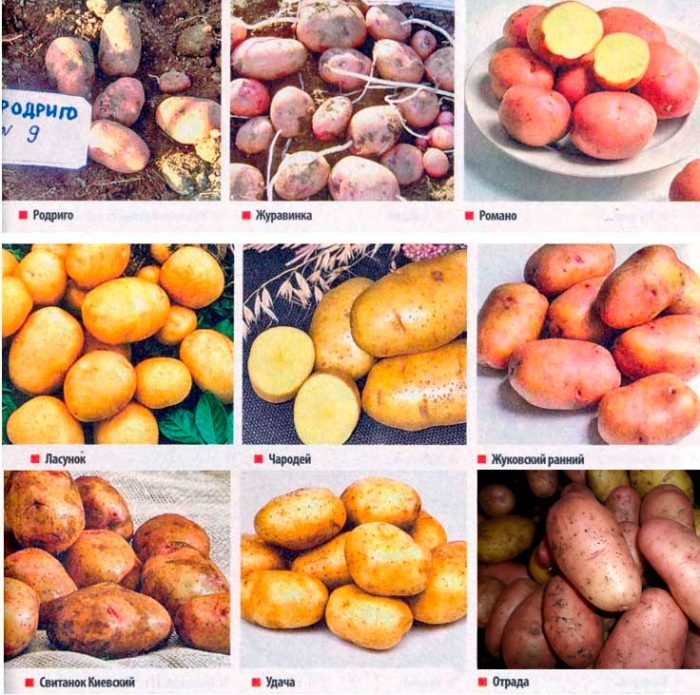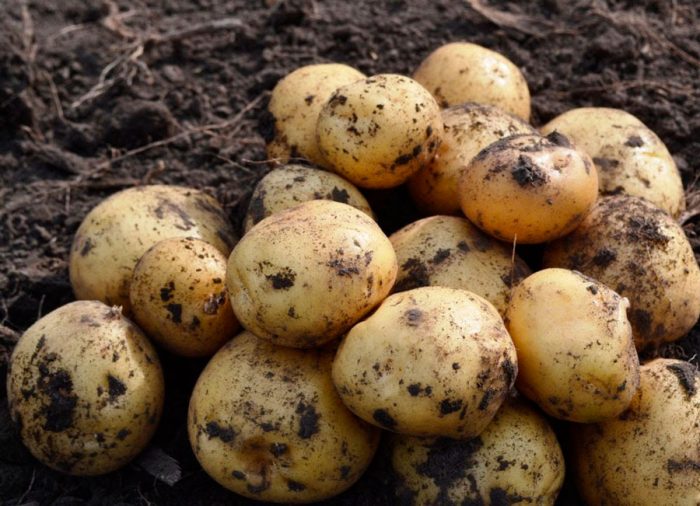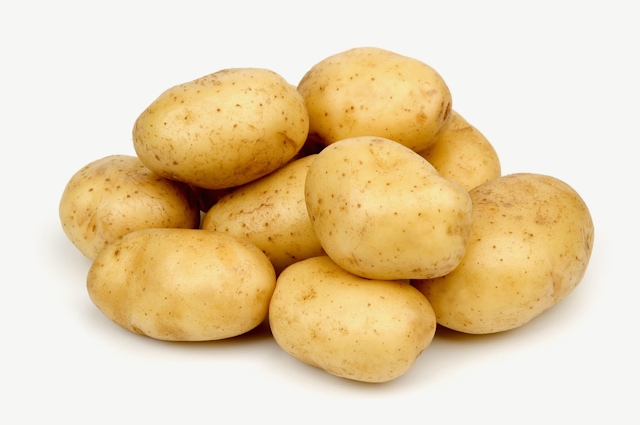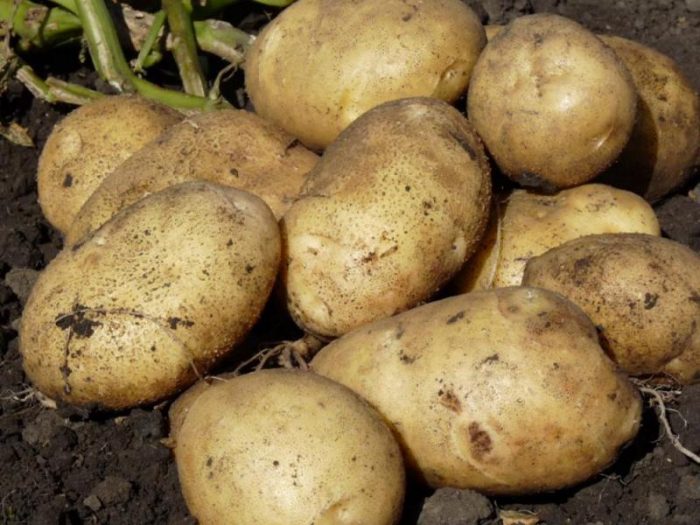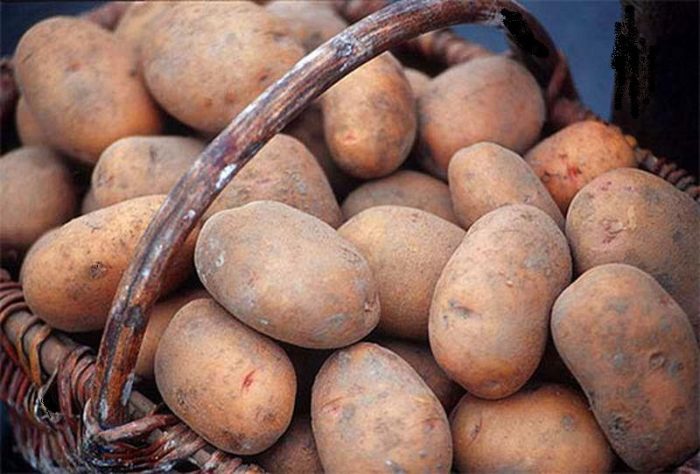Potatoes (Solanum tuberosum), also called the nightshade tuberous, is a type of tuberous herbaceous perennial plants belonging to the genus Solanaceae of the Solanaceae family. In 1596 Kaspar Baugin, who was a Swiss anatomist and botanist, as well as a taxonomist of the plant world, gave the potato its modern scientific name. At the same time, Karl Linnaeus, composing his own classification of plants, entered this name into it. In Russia, this plant is called "potato" - this word is derived from the Italian "tartufolo", which translates as "truffle". The homeland of this plant is South America, on its territory, and today you can meet wild-growing potatoes. People began to grow it at least 9000-7000 years ago, and this happened on the territory of the modern state of Bolivia, while the Indian tribes used potatoes as food, and also deified it. The tubers of this plant helped to measure the time of the Incas, the fact is that they were cooked for about 1 hour. There is an opinion that the potatoes got to the territory of Europe thanks to the Spanish historian and the first chronicler of the Conquista Pedro Cieza de Leon, who returned from Peru in 1551. In Spain, this culture came to Italy, Holland, England, Germany, Belgium, France, and later to other European countries. But at first, potatoes were grown in Europe as an ornamental exotic plant. Everything changed after the French agronomist Antoine-Auguste Parmentier was able to prove that potato tubers have high taste and nutritional qualities. As a result, during the lifetime of this agronomist, scurvy and hunger in the provinces of France were overcome. On the territory of Russia, this crop appeared during the reign of Peter I. The agricultural policy of the Russian state in the 19th century contributed to the increase in potato crops. Already at the beginning of the 20th century, this culture was considered one of the main food products. And in 1995, a vegetable was grown in space for the first time, and it was a potato.
Content
Features of potatoes
Potato bushes are about 100 cm high. Its ribbed shoots are bare, and their lower part, immersed in the ground, forms stolons, which can reach half a meter in length. At the ends of the stolons, tubers are formed, which are modified buds; they include starch cells, which are enclosed in a thin shell, consisting of cork tissue. The dark green unpaired leaf plates are pinnately dissected. On the tops of the shoots there are shields, consisting of flowers of white, pink or purple color. The fruit is a poisonous polysperm, reaching 20 mm in diameter, it is colored dark green and outwardly similar to a small tomato. The alkaloid solanine is a part of green tissues, it protects it from bacteria and some pests. In some cases, solanine can also be produced in tubers, in this regard, it is highly undesirable to use green root vegetables for cooking.
Potatoes are grown not only for food, but also for sale. For its reproduction, a vegetative method is used, namely, root crops or their parts. This plant can be propagated by seeds, but this is done only in the case of a breeding experiment or if you need to save money, because potato tubers are several times more expensive than seeds. Also, a plus of seed propagation is that they do not need to be stored in the cellar. If seeds are used to grow varietal potatoes, then in this case it will be possible to renew all planting material, the fact is that the seeds are very resistant to viruses and bacteria, unlike tubers. However, it should be borne in mind that it is quite difficult to grow a potato from a seed, and an inexperienced gardener may not even be able to do this. In this regard, experts advise using a proven and reliable method, namely, to grow potatoes from tubers.
Planting potatoes in open ground
Potatoes are planted in open soil in the last days of April or the first in May after the weather is good, and the foliage on the birch will be equal to a small coin. You also need to check the soil, at a depth of 100 mm it should be warmed up to 10 degrees.
Before you start planting, you need to process the tubers, and you should also start preparing the soil on the site. It is recommended to select material for planting in the autumn during the harvesting process. For planting, root crops taken from absolutely healthy plants are ideal, the weight of which should be equal to 70-100 grams. It is not recommended to use very small tubers for planting, otherwise the gardener not only risks being left without a crop, but also because of this, the degeneration of varieties can be observed. Tubers, selected for seeds, must be laid out in the light and you must wait until they turn green. The planting material prepared in this way is different in that it is stored much better and longer, and rodents bypass it. In the last winter weeks, it is necessary to inspect the planting material, while all the shoots, if any, must be cut off (they can be used for growing seedlings). 4-6 weeks before planting, remove the planting material from storage and store it in a well-lit and cool (12 to 15 degrees) place where the tubers will need to germinate. To do this, it is recommended to spread them on the floor in 1 layer or put them in boxes, while each layer should be sprinkled with peat or moistened sawdust.After a while, inspect the roots, if strong sprouts have appeared on them, reaching 10-15 mm in length, then this means that they can already be planted. If the planting material is already ready for landing, but it is too early to plant, then it is recommended to temporarily remove it in a dark place. Before proceeding with planting, it is necessary to process the tubers with a growth-stimulating agent, for example, a solution of Epin or Zircon.
Planting rules in spring
If the potato planting material was purchased in the year of planting, and its quality is in doubt, then in this case it is recommended to process it against infections, for this, the root crops are kept in a boric acid solution (1%) for a third of an hour or they are immersed in slightly hot (from 40 to 43 degrees) water for 20 minutes.
Potato soil
For planting, use a sunny area from north to south. Potatoes grow best in soil with a pH of 5–5.5, but they can also be grown in acidic soil. This vegetable crop prefers light and medium soils: sandy, black earth, loamy and sandy loam. When grown in heavy clay soil, the development of root crops is significantly impaired due to the very high density of the soil, as well as insufficient air. And if such soil also contains a large amount of moisture, then this can cause rotting of the bushes.
The preparation of the site for planting potatoes should be done in the autumn. To do this, it is dug to a depth of 0.3 m with the seam overturning, all weeds should also be removed from it and 100 grams of wood ash and 3 kilograms of humus per 1 square meter of land should be added to the soil.
Then you can plant potatoes
Best of all, this vegetable crop grows in the area where cucumbers, greens, beets, cabbage and siderates were grown before it. For planting it, those areas where representatives of the Solanaceae family were previously grown (sweet peppers, potatoes, tomatoes and eggplants) are not suitable.


Watch this video on YouTube
Landing rules
Potatoes are planted in moist soil. The depth of the holes is influenced by the composition of the soil. So, the heavier and denser the ground on the site, the shallower the depth of the hole should be. For example, if the soil is sandy or sandy loam, then the tubers should be deepened by 10–12 centimeters, and if clayey - by 4–5 centimeters. The planting method is also directly related to the composition of the soil. If the soil is light (sandy loam, black soil, sand or loam), then grooves or holes are made for planting potatoes, but if it is dense, damp and does not warm up well, then they resort to planting with a ridge method. If a smooth planting is used, then the root crops should be spread out along the grooves or pits, while first one handful of wood ash must be thrown into them, which is considered the best fertilizer for this crop. The distance between the pits or between the potatoes in the furrow should be about 0.35 m, while the row spacing should be at least 0.7 m, as a result, the gardener will have enough land while hilling the bushes. On heavy soil, planting is carried out using a cultivator, they cut ridges, the height of which should be no more than 12 centimeters, and their width - about 0.65 m.On loamy soil, root crops are embedded to a depth of 60 to 80 mm, and on sandy loam - 80–100 mm from the top of the ridge.
In recent years, more and more gardeners have begun to grow potatoes under straw. This is done very simply: the potatoes are evenly distributed over the surface of the site, after which they are sprinkled with a sufficiently thick layer of straw. As the bushes grow, you need to add straw on top. This unusual method has clear advantages, namely, the potatoes grow clean and of excellent quality, and it is very easy to dig them out. But he, like other methods, has disadvantages: mice like to live in straw and it is also excessively dry in it.
Potato care
To grow potatoes in open soil, they need to be well and properly cared for, and this should be started before the shoots appear. The site must be loosened and weeded in a timely manner, in this case, the roots in the ground will get air.Before the emergence of shoots, you can loosen the soil surface with a rake. After the potatoes sprout, you need to regularly loosen the soil surface between the rows, and this should be done every time it rains or the plantings are watered. Avoid crusting on the soil.
Taking care of potatoes is relatively simple: you need to water it in a timely manner, loosen it, remove weeds, huddle, feed and process it against harmful insects and diseases.
How to water
Before buds begin to form on the bushes, this crop does not need to be watered. However, as soon as the budding period begins, care must be taken to ensure that the soil on the site is moist all the time. Watering should be done only after the land on the site dries out to 60–80 mm. Watering should be done in the evening, while 1 bush takes from 2 to 3 liters of water. When the site is watered, you should loosen its surface.
Hilling potatoes
Over time, the grown bushes will need hilling, for this, the soil should be shoveled under the base of the potato, capturing it from the rows. As a result, the area will look ridged, even if a smooth planting method was used. Hilled bushes will not fall apart, and also stolons will grow more actively, and they contribute to the formation of the crop. You need to spud potato bushes at least 2 times per season. The first hilling is carried out after the height of the bushes is 14-16 centimeters, and the plants should be hilled again 15-20 days later, before they bloom. The easiest way to huddle the bushes is when they are watered or it is raining.
Fertilizer
For feeding this culture, organic matter is used, namely: a solution of chicken manure or slurry. If necessary, the plants are fed with a solution of mineral fertilizer. But before you start feeding, you should think about what the composition of the soil is and how much fertilizer was added to it before planting the potatoes. Try not to disturb the nutrient balance of the soil, remember that applying a very large amount of fertilizer will have an extremely negative effect on the quality of the crop.


Watch this video on YouTube
Potato processing
Colorado potato beetle control
When cultivating potatoes, you should be prepared for the Colorado potato beetle to settle on the bushes. Therefore, you need to know how to deal with it. You can resort to folk methods, for this you need to plant calendula on the site with potatoes, or you can treat the surface of the site with wood ash, which must first be sieved. Also, this pest can be scared away by beans or beans, which should be planted around the perimeter of the site. You can also make an unusual bait for the beetle. To do this, 15 days before planting potatoes, several root crops should be planted on the site, most of the beetles will flock to the grown bushes, and they will need to be dug up and destroyed along with pests. If traditional methods turned out to be ineffective, then process the plants with Aktara, Prestige or Confidor.
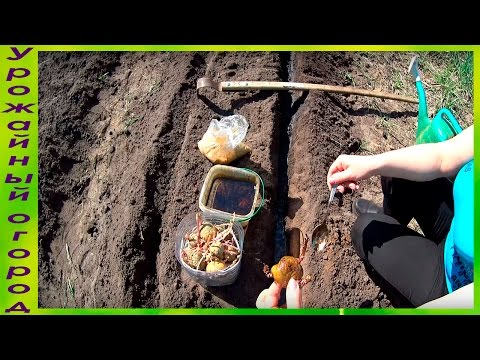

Watch this video on YouTube
Potato pests and diseases with photo
Potatoes can become ill with late blight, rhizoctonia, macrosporiosis, scab, cancer, stem rot, phomosis, brown spot and leaf bronzing. It is very important to know the first symptoms of these diseases:
Rhizoctonia
In diseased bushes, damage to the vascular system of the roots, as well as shoots, is observed, as a result of this, the formation of tubers occurs on the tops in the sinuses. The ascended bushes weaken, thin out, and their color changes to light red.
Phytosporosis
On the foliage and shoots of the affected bushes, specks of brown color of various shapes with light green bordering are formed. At the same time, a light-colored bloom appears on the seamy surface of the leaves, which contains the spores of the fungus-causative agent of this disease.
Stem rot
In an infected plant, stems and foliage begin to wilt. In the lower part of the shoots, specks of a dark color are formed; over time, necrotic spots with a yellow rim appear on the aerial parts of the bush.
Brown spot
In diseased bushes, concentric specks of a dark color form on the lower leaf plates, after a while a black bloom appears on their surface, which contains fungal spores. The most intense development of the disease is observed in hot and damp weather.
Scab
Infected potatoes are damaged underground. Ulcers appear on the surface of root crops, which, as the disease progresses, grow and become corky.
Macrosporiasis
In the affected bush, concentric spots of brown color appear on the foliage, and putrefactive formations with a bloom of black appear on the roots.
Fomoz
On the shoots of a diseased plant, vague spots are formed that have an elongated shape and have pycnidia. As the disease progresses, discoloration is observed. After the roots are dug out, dry rot appears on them, it is spots, reaching 20-50 mm in diameter, which are located on the surface of the tuber. In some cases, voids with gray mycelium appear in potatoes.
Potato cancer
In a diseased plant, the entire bush is affected, only the roots remain intact. In such bushes, tissues grow and growths appear that are outwardly similar to cauliflower.
Bronze of leaves
This disease develops due to a lack of potassium. In the affected bush, the foliage is painted in an excessively dark color, as the disease progresses, it develops a bronze tint, and necrotic dots form on the surface. In potato bushes grown on peat and sandy soil, the likelihood of being affected by such a disease is relatively higher.
If the bushes have symptoms of leaf bronzing, then they can be cured by applying fertilizer that contains potassium to the soil. Other diseases are fungal, and in order to cure the bushes, it is necessary to use fungicidal preparations, for example: Skor, copper oxychloride, Maxim, Topaz and others. If you want to avoid the development of diseases in this plant, then provide it with proper care, do not forget about the agrotechnical rules of this crop, be sure to process the tubers before planting and adhere to the rules of crop rotation.
Harmful insects can also harm this culture. The greatest danger is the Colorado potato beetle, which was described in detail above, as well as the wireworm (the larva of the click beetle), it can live in the soil for several years. It is recommended to make traps to get rid of the wireworm. To do this, several holes should be dug on the site, the depth of which should be about half a meter, pieces of sweet root vegetables, for example, carrots or beets, are laid in them. From above, the hole should be covered with a shield made of wood or plywood or a metal sheet. After 2 days, you need to inspect the traps, all vegetables, along with pests, must be destroyed.
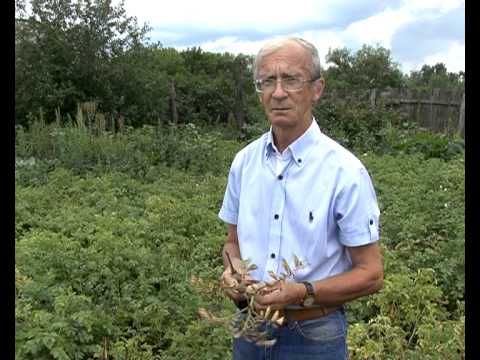

Watch this video on YouTube
Cleaning and storing potatoes
What time to harvest
As a rule, you can start harvesting potatoes after the tops on the bushes turn yellow and dry. As a rule, harvesting is carried out 70–100 days after the tubers are planted in the open ground. To be sure that it's time to dig the potatoes, you should remove a few bushes from the ground, if the roots are ripe, then you can start harvesting.Remember that the harvesting of root crops should not be postponed until later, since if the tops are completely dry, and the tubers will then remain in the ground for a long time, then their mass will significantly decrease, and this will also negatively affect their storage ability.
Experienced gardeners advise, if possible, 15 days before harvesting, to shorten the potato tops to 10 centimeters by mowing them. Then you should collect and destroy it, since harmful insects, as well as pathogens, can accumulate in it during the season. Harvesting should be done on a sunny, dry day. To dig out bushes, you can use a walk-behind tractor, a fork with blunt arrows, or a shovel. It is recommended to leave the dug roots on the surface of the site for a while so that they can dry out. After that, they need to be collected and poured into bags, which are removed to a shaded place (for example, a dry shed), where they will stay for 15 days. At the end of the allotted period, the peel on the tubers will become stronger and denser, and the infected root crops will have time to show signs of the disease. It should be borne in mind that all this time the potatoes can be in bags, but if possible they are poured out of them onto the floor (the layer thickness should not be more than 0.5 m). When half a month has passed, you can start sorting the potatoes, while you need to remove all damaged by the disease, as well as injured tubers, and you should also choose potatoes belonging to those varieties that cannot be stored for a long time. The potatoes can then be removed to storage. Do not forget to select planting material for the next season, it must be kept in a well-lit place until the tubers develop a green tint. Then the seed potatoes are also placed in storage.
For storing such root crops, it is recommended to use a cellar or basement, the main thing is that the storage is cool, dry, dark and has good ventilation. It should also be protected from rain, and also from frost. It is very convenient to use trellised trays for storing potato tubers. Of these, it is recommended to make rather spacious bins, into which root crops must be poured in a layer no thicker than half a meter. The bottom and walls of such a bin will be lattice, air will be able to flow freely to the potatoes. For storage, you can also use small wooden boxes for apples, which should be stacked on top of one another. In order for the root crops to be stored better, it is recommended to shift them with rowan leaves. The best storage conditions for root crops: air humidity from 85 to 90 percent, and temperature - from 2 to 3 degrees. If it is warmer in the storage, the sprouts will grow very early, and solanine, dangerous for the human body, will begin to accumulate in the tubers, but if it is colder there, the tubers will freeze, as a result of which they will acquire a very sweet taste. In the absence of a utility room, or if there are no conditions for storing this vegetable, then potatoes can be placed in fabric bags on the balcony, but they should first be folded into wooden containers in which there are holes for ventilation. The container should not be placed on the floor or placed near a wall. On each side, as well as at the bottom of the container, there should be a gap of 15 centimeters, this is necessary for good ventilation. With the onset of frost, the container with potatoes must be covered with an unnecessary blanket or carpet, in this case the tubers will be able to withstand the temperature drop to minus 15 degrees. If the roots are placed in a corridor, living room or storage room, then they can lie there for no more than 12 weeks.
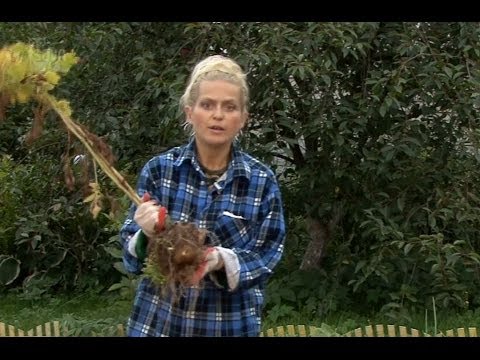

Watch this video on YouTube
Types and varieties of potatoes
All varieties of potatoes for economic purposes are divided into:
- technical - they contain more than 16 percent of starch;
- universal - potatoes contain from 16 to 18 percent starch;
- fodder - root crops are relatively large, they contain a large amount of protein;
- canteens - contain a large amount of protein and vitamin C, and starch is not less than 18 percent.
And all table varieties are divided into 4 types:
- type A - the pulp of the tubers is dense and not boiled;
- type B - powdery dense pulp is boiled down only a little;
- type C - potatoes of medium powderiness, the flesh is soft and very boiled;
- type D - potatoes are completely boiled.
Type A is suitable for a wide variety of salads, type B and type C for mashed potatoes, fries and chips, and type D for only mashed potatoes. In different varieties, the roots can be colored in different colors: red, pink, purple, white or yellow.
Also, potato varieties are divided into 6 groups according to ripening periods:
Super early varieties
Harvesting is carried out after 34-40 days from the moment of planting. Varieties:
- Ariel - this table variety is distinguished by its high yield, the tubers are light yellow, the pulp is creamy and has a pleasant taste, the average mass of potatoes is about 170 grams, cooked potatoes are not subject to darkening;
- Riviera - the variety is distinguished by a high yield, during one season it can bear fruit twice, large brownish smooth oval-shaped potatoes have a very tasty yellow pulp;
- Minevra - this variety has a high yield, and is also resistant to cancer and scab, it is suitable for long-term storage, the roots are white, and the pulp is yellow and very tasty, it contains about 17.5 percent starch;
- Bellarosa - the variety is distinguished by unpretentiousness, drought resistance and high productivity, light red potatoes have an oval shape and very tasty yellowish pulp.
Early maturing varieties
Harvesting is carried out after 50–65 days after planting. Popular varieties:
- Impala - the variety has a high yield, for example, up to 13 smooth yellow oval-shaped root crops grow in one bush, they rapidly increase their mass, their flesh is yellowish and dense;
- Red Scarlett - this variety was bred by Dutch breeders, the bush is low and semi-sprawling, large red roots weigh about 140 grams and have a yellowish flesh;
- Dnipryanka - this Ukrainian variety is distinguished by its yield, it can give 2 harvests in 1 season, is suitable for long-term storage, oval roots are yellow, they have a creamy pulp and a small number of eyes, after cooking potatoes are not subject to blackening;
- Rosalind - the variety has a high yield, the flesh of pale red root crops is yellow, and the eyes are shallow, on average a potato weighs about 100 grams, and it contains 17 percent starch.
Medium early varieties
Harvesting is carried out 65–80 days after planting. The following varieties are popular:
- Sineglazka - this variety is distinguished by its unpretentiousness and high yield, gray roots have lilac eyes and tasty white pulp;
- Fun - the Ukrainian variety, which is distinguished by its yield, has an average size of pink root crops (average weight 120 grams), their white pulp has a high taste and low starch content;
- Mriya - this variety is resistant to diseases (for example, to cancer and rot) and high yields, potatoes taste similar to Sineglazka, pink root crops have a yellowish and tasty pulp, which contains a large amount of starch;
- Nevsky - white tubers weigh on average about 130 grams, they have a blunt top and pale red eyes, white flesh does not darken on the cut, starch contains only 11 percent.
Mid-season varieties
Harvesting is carried out after 80–95 days from the moment of planting. Varieties:
- Picasso - this productive Dutch variety does not need frequent watering, up to 17 white root crops can grow on one bush, there are red spots on their surface, and their flesh is creamy;
- Santa - the table variety is distinguished by its unpretentiousness and productivity, yellow large and smooth tubers are oval in shape, and small eyes are located on the surface, creamy tasty pulp contains a small amount of starch;
- Peter's riddle - this prolific variety is suitable for long-term storage, the pink roots have a pinkish-creamy, very tasty pulp.
Medium late varieties for the winter
Harvesting is carried out after 95-110 days from the moment of planting. The best varieties:
- Desiree - this variety, suitable for long-term storage, has a high yield and resistance to drought, red roots have tasty yellow flesh, which contains 21.5 percent starch;
- Kuroda - the Dutch variety is resistant to diseases, boiled potatoes do not darken, pale red roots are oval in shape and yellow flesh, which contains a large amount of starch (about 21 percent);
- Zdabytak - this Belarusian variety is among the best in this group, yellow oblong root crops have yellow pulp, which contains about 25 percent of starch, up to 22 potatoes can grow on one plant.
Late-ripening varieties
Crop is harvested when 110 days or more have passed since planting. Varieties:
- Orbit - the variety is resistant to viral diseases and scab, yellow rounded roots have tasty white flesh, which contains 19 percent starch;
- Zarnitsa - the variety is resistant to late blight, scab and viral diseases, the flesh of violet-red root crops is yellow with a low starch content;
- Cardial - the variety is suitable for long-term storage, it is resistant to drought and diseases, as well as high yield, elongated roots have a red color, superficial eyes, very tasty yellowish pulp.
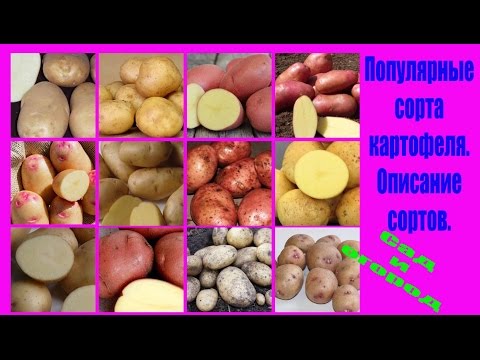

Watch this video on YouTube


